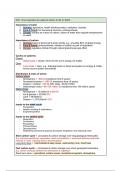KQ1: How important are water & carbon to life on Earth
Importance of water
1. Humans: agriculture, health (drinking water), sanitation, industry
2. Flora & Fauna: for biomass & structure, photosynthesis
3. Climate: oceans as a store of carbon, stores of water also regulate temperatures
on earth
Importance of carbon
1. Humans: basis of almost all human activity e.g., provides 80% of global energy
2. Flora & Fauna: photosynthesis, release of carbon as part of respiration
3. Climate: regulates climate through natural greenhouse gas effect
Cycles as systems:
Closed
- Global scale = closed, driven by the sun’s energy not matter
Open
- Local scale = open, e.g., drainage basin or forest ecosystem so energy & matter
moves across system boundaries
Distribution & sizes of stores
Carbon stores
- Atmosphere = ~600 Gt (residence time 6 years)
- Terrestrial biomass = ~560 Gt (residence time 18 years)
- Oceans = surface ~700 Gt (25), deep ~38,00 (1250)
- Sedimentary rocks = 60-100 million Gt (residence time 150 million years)
Water stores
- Atmosphere = 13,000km3/ 0.0001%
- Ice & glaciers = 29,000/ 2%
- Land = 39,000km3
- Oceans = 1,370,00km3/ 97%
Inputs to the water cycle
- Precipitation
- Ablation (melting & sublimation)
- Evapotranspiration
Inputs to the carbon cycle
- Respiration
- Combustion
- Precipitation
- Photosynthesis
- Decomposition
- Weathering (chemical & physical processes breakdown rock releasing CO2)
Slow carbon cycle = processes & carbon storage over long geological timescales
E.g. chemical weathering- carbonation result of precipitation = weak acid attacking carbonate
minerals in rocks, releasing CO2 in the atmosphere
Long term store = intermediate & deep ocean, sedimentary rock, fossil fuels
Fast carbon cycle = processes & carbon storage over short geological timescales
E.g. carbon exchange between the atmosphere & vegetation
Short term store = permafrost, surface ocean, terrestrial ecosystem, atmosphere
, Processes (link various stores)
Water cycle
- Precipitation (movement of surface & soil water into underlying impermeable rock)
- Evapotranspiration
- Run-off
- Infiltration
- Percolation
- Throughflow (water flowing horizontally through the soil to the stream & river channel)
Carbon cycle
- Photosynthesis
- Respiration
- Decomposition
- Combustion
KQ2: How do the water & carbon cycles operate in contrasting locations
Case study of a tropical rainforest (Amazon)
Water cycle (flows & stores)
Temperature
- 25-30 degrees (due to intense insolation throughout the year)
Precipitation
- High average rainfall >2000mm with no dry season
- 50-60% of precipitation is recycled back into the atmosphere by evapotranspiration
(convectional rainfall- ground heated up in the morning by intense solar radiation)
- 10% of precipitation is intercepted by forest trees
(due to abundance of vegetation- forest trees)
Evapotranspiration
- High due to hot temperatures, moisture & vegetation
- Feedback loops-> sustain high precipitation
- Hence ~50%-60% of rainfall is returned to the atmosphere via evapotranspiration
Run-off
- River discharge may peak depending on seasonal variation of rainfall
Atmosphere
- Store large amounts of moisture due to high temps-> high absolute & relative
humidity
Physical factors affecting stores & flows of water
1. Geology: large parts of Amazon basin are an ancient shield area comprising of
impermeable, crystalline rocks (igneous & metamorphic) with minimal storage
capacity-> high rapid run-off
2. Relief: mainly lowlands, gentle relief = water moves across surface (throughflow)
to streams & rivers
3. Temperature: high temperatures = high rates of evapotranspiration
Human factors affecting stores & flows of water
1. Deforestation: est 1970 ⅕ of primary forest destroyed-> reducing water storage in
forest trees, soils (eroded) & permeable rocks (due to more rapid run off). In terms
of flows less evapotranspiration & thus precipitation
Significance- huge on water cycle & may change climate at local & regional
scales converting rainforest to grassland-> increases run-off by a factor of 27





